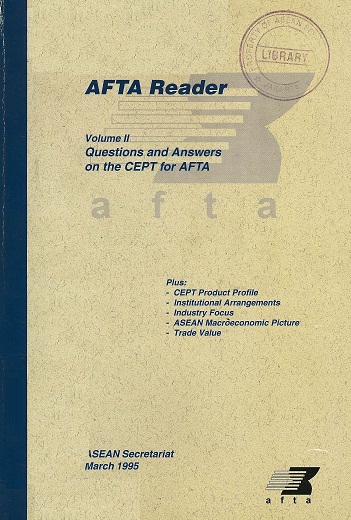AFTA Reader  | Subtitle : Volume 2: Question and Answer on the CEPT for AFTA
Abstract :
This is the second volume of the AFTA Reader. It continues the tradition of providing basic information about the background, status and future direction of the ASEAN Free Trade Area (AFTA) and the major instrument for achieving it, namely the Common Effective Preferential Tariff (CEPT) Scheme.
It has now been two years since the landmark launching of the ASEAN Free Trade Area (AFTA) and the implementation of the CEPT package is very well in progress. The commitment of the ASEAN Governments to AFTA and trade liberalisation remains the driving force for the eventual realisation of a dynamic free trade grouping in the region. The measures in the CEPT Scheme will serve to ensure that intra-regional trade and investment are facilitated and enhanced, with the objective of reducing as much as possible all obstacles to the flows of goods and capital in the region. This, no doubt, will enhance the rapid growth and competitiveness of the ASEAN economies and increase the attractiveness of the region to foreign investors. Together with the political and economic stability of the region, built from almost thirty years of cooperation and partnership in ASEAN, these provide a conducive business environment for entrepreneurs both within and outside ASEAN. Given ASEAN's commitment to AFTA, the economic prospects for the region continue to be bright.
This volume continues the Question & Answer format initiated in the first volume of the Reader. This remains an important conduit of information between both the private and Government sectors on issues relating to the implementation of CEPT for AFTA. The questions are mainly those posed to us at the Secretariat by the private sector and are deemed crucial to the successful implementation of AFTA. We welcome any queries and questions on CEPT for AFTA. In this volume, we provide information on focal points in the ASEAN Governments and at the ASEAN Secretariat to which queries may be posed.
We also take a look at the CEPT Scheme in detail. In particular, we examine the products which is covered under the CEPT. This comprises two groups the. products for temporary exclusion and those for inclusion. The large coverage of the CEPT Scheme on many products is evident here ie. 88% of the tariff lines in ASEAN are included in the Scheme, each with a tariff reduction schedule.
Manufacturing industries have been the cornerstone of ASEAN's industrialisation process, and it is likely that these industries will continue to be the driving force of economic growth and dynamism in ASEAN, and will continue to integrate the economies in AFTA. The effects of the CEPT for AFTA on these industries are indeed favourable both in terms of increasing the region's competitiveness and the possibilities for greater intra-and inter- industrial linkages within the region. We therefore take a look it important industries in ASEAN, those which have the largest number of tariff lines in the Scheme and assess the tariff reductions in them. The industries covered include agriculture, electronics, machinery and textiles.
In the next issue we will continue to deal with on-going implementation issues on CEPT for AFTA, including information on the latest decisions affecting the CEPT. In the meantime, it is hoped this issue will be both useful and informative. Any comments or opinions are welcomed.
Registration No : B833
Author :
Asean Secretariat
Edition :
Impresum : Jakarta: ASEAN Secretariat, 1995
Description :
Language : English
ISBN 085462233337
Classification:
1. 200 - ECONOMIC COMMUNITY / 210.3 - TRADE AND FACILITATION - ASEAN Single Window
Keyword :
1 AFTA
2 industry
3 macroeconomic
Availability :
Hard copies 18 of 18
◀ Return to Category Page |
Related Literatures |
You are not logged in yet
Please log in before you can start to reserve a book. If you don't have a username and password please contact our administrator.
|